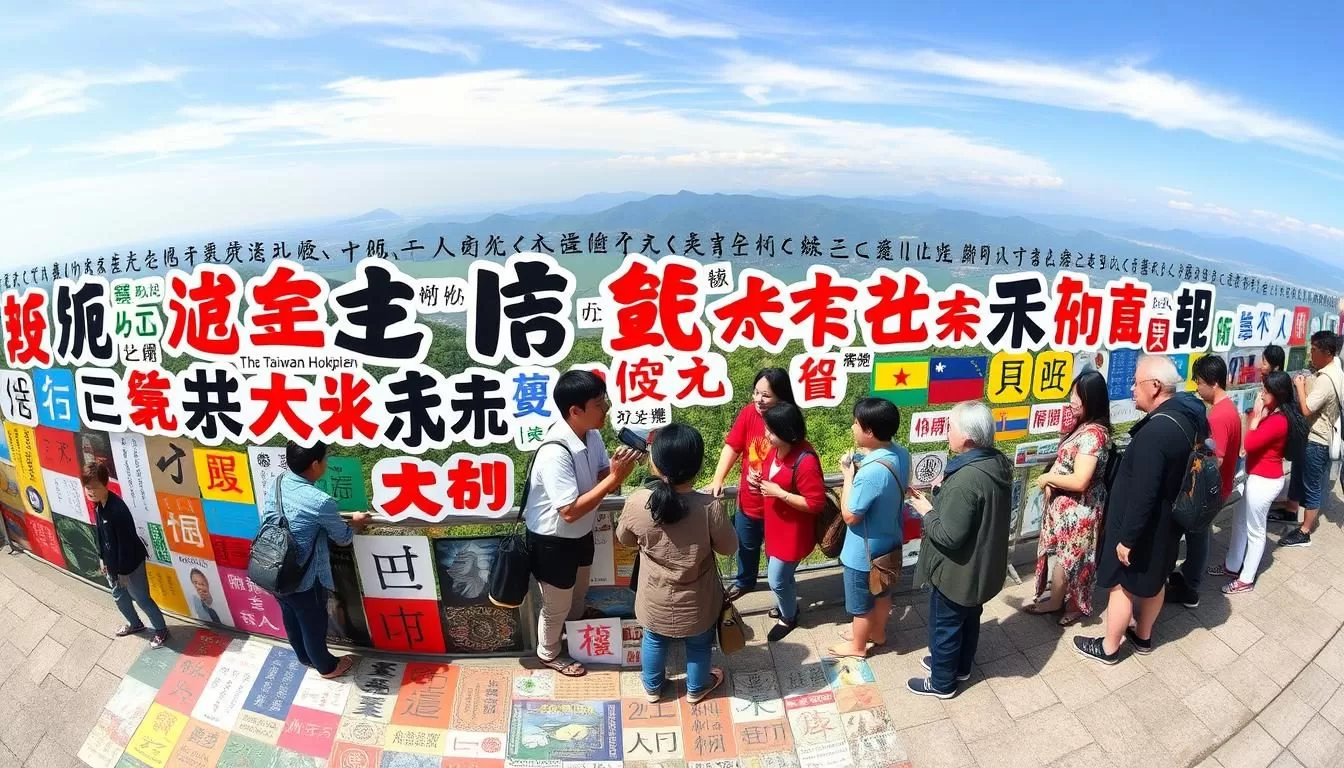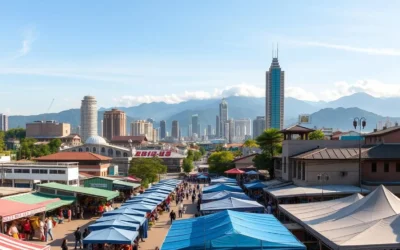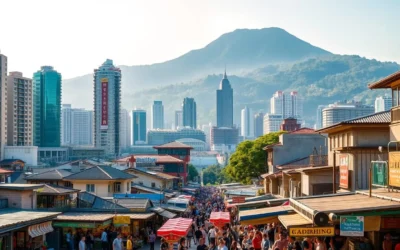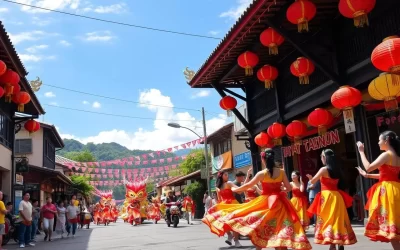✓ Accommodations✓ Flights✓ Rental Cars
As you plan your visit to Hualien County, understanding the local language situation can significantly enhance your travel experience. The population of this region is diverse, comprising Han Chinese settlers and several indigenous tribes, each contributing to the area’s linguistic diversity.
The official language of Taiwan is Mandarin Chinese, widely used in government, education, and media. However, the languages spoken in Hualien County reflect the region’s complex history and cultural heritage. With a rich linguistic landscape that includes Taiwanese people speaking various dialects and languages, you’ll find that understanding the local language can deepen your appreciation of the area’s cultural identity.
As part of the Republic of China, Taiwan’s linguistic diversity is shaped by its history and cultural influences. This guide will help you navigate the languages and dialects you may encounter during your visit.
The Linguistic Landscape of Hualien County
As you explore Hualien County, you’ll discover a rich tapestry of languages that set it apart from other parts of Taiwan. This diversity is rooted in the county’s unique history, geography, and cultural heritage.
Geographic and Demographic Context
Hualien County is located on Taiwan’s eastern coast, separated from the western part of the island by the Central Mountain Range. This geographic isolation has contributed to the preservation of linguistic diversity in the region. The population of Hualien County is a mix of indigenous peoples, Hakka, Hokkien, and other groups, creating a complex demographic landscape.
Language Diversity in Eastern Taiwan
The linguistic landscape of Hualien County is characterized by a balance between indigenous languages, Hakka, Hokkien, and Mandarin Chinese. Unlike western Taiwan, where Taiwanese Hokkien dominates as the second most common language, Hualien features a more diverse linguistic profile. The table below illustrates the language distribution in Hualien County:
| Language Group | Prevalence | Characteristics |
|---|---|---|
| Indigenous Languages | High in mountain communities | Diverse, with languages such as Amis, Truku, and Sakizaya |
| Hakka | Significant presence | Influenced by Hakka cultural traditions |
| Hokkien | Common in coastal urban areas | Similar to Hokkien spoken in other parts of Taiwan |
| Mandarin Chinese | Official language, widely used | Used as the lingua franca throughout Taiwan |
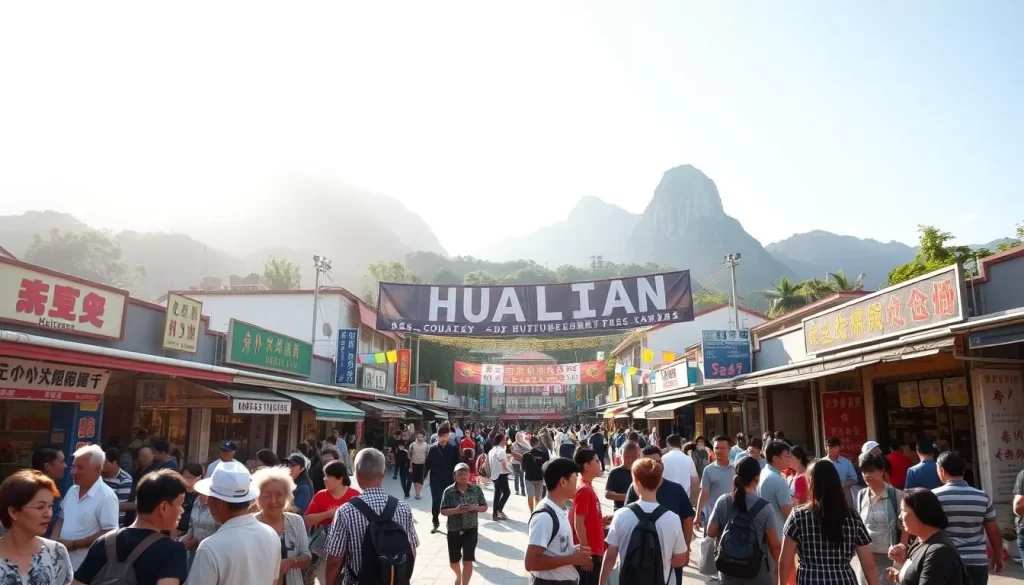
Recent government initiatives have focused on preserving and revitalizing the linguistic heritage of eastern Taiwan, recognizing its cultural importance. As a result, Hualien County continues to be a fascinating example of linguistic diversity in Taiwan.
Mandarin Chinese: The Official Language
Hualien County, like the rest of Taiwan, recognizes Mandarin Chinese as its official language, integral to its societal fabric. As the primary means of communication in official contexts, education, and media, Mandarin Chinese plays a crucial role in the daily lives of the people in Hualien County.
Status and Usage in Hualien County
In Hualien County, Mandarin Chinese is not only the language of officialdom but also the lingua franca among people of different linguistic backgrounds. Almost everyone in Hualien County can speak Mandarin, making it a unifying factor across the county’s diverse population.
Characteristics of Taiwanese Mandarin
Taiwanese Mandarin has developed distinctive characteristics that reflect Taiwan’s unique history and cultural influences. Some notable features include:
- The preservation of certain sounds that have merged in mainland Mandarin, such as the distinction between “zh” and “z” sounds.
- The incorporation of unique terms and expressions, including loanwords from Japanese and indigenous languages, particularly common in Hualien.
- Code-switching between Mandarin and other languages, such as Taiwanese Hokkien, creating a hybrid linguistic environment.
- The use of traditional Chinese characters, maintaining connections to classical Chinese literature and culture.

Indigenous Languages of Hualien County
Hualien County is home to a diverse range of indigenous languages, each with its own unique cultural significance. As you explore the region, you’ll discover that these languages are an integral part of the local identity and cultural heritage.

Amis: The Most Widely Spoken Indigenous Language
Amis is the most widely spoken indigenous language in Hualien County. It is spoken by the Amis people, who are the largest indigenous group in the region. Efforts are being made to document and preserve the Amis language, including the development of language learning materials and cultural programs.
Truku and Sakizaya Languages
In addition to Amis, other indigenous languages spoken in Hualien County include Truku and Sakizaya. These languages are also being preserved through language documentation and cultural revitalization efforts. The Truku language, for example, is being promoted through language classes and cultural events.
Current Status and Revitalization Efforts
Despite the challenges faced by indigenous languages in Hualien County, there are several initiatives underway to revitalize and promote their use. These include:
- Mandatory indigenous language classes in schools with significant indigenous populations.
- The establishment of language nests (immersion programs) in several Hualien communities.
- Digital initiatives, such as smartphone apps and online dictionaries, to make indigenous languages more accessible.
These efforts aim to preserve the cultural heritage and linguistic diversity of Hualien County, ensuring that its indigenous languages continue to thrive for generations to come.
Taiwanese Hokkien in Hualien County
Taiwanese Hokkien is an integral part of the linguistic landscape in Hualien County. As you explore the region, you’ll notice the unique flavor of Hokkien spoken here, shaped by the county’s history and demographic makeup.
Prevalence and Usage Patterns
Taiwanese Hokkien is widely used in everyday life in Hualien County. You’ll hear it in local markets, community gatherings, and among friends. The language has a strong presence, particularly among the older population and in more traditional settings. However, the influence of Mandarin Chinese, the official language, is also evident, especially in formal situations and among the younger population.
Regional Variations in Eastern Taiwan
The Taiwanese Hokkien spoken in Hualien County exhibits distinct differences from the varieties spoken in western Taiwan. For instance, Hualien’s Hokkien dialect shows a stronger influence from the Zhangzhou variant of Southern Min.  Additionally, the Hokkien spoken in Hualien contains more loanwords from indigenous languages and Japanese, reflecting the region’s unique history. These variations offer valuable insights into how geography and population movements have shaped the language over time.
Additionally, the Hokkien spoken in Hualien contains more loanwords from indigenous languages and Japanese, reflecting the region’s unique history. These variations offer valuable insights into how geography and population movements have shaped the language over time.
Hakka Language Communities
The Hakka language, an integral component of Taiwan’s cultural heritage, thrives in Hualien County. As part of the broader linguistic landscape of Taiwan, the Hakka language is maintained by the Hakka Affairs Council, a governmental agency that also operates Hakka TV and Radio stations.
Distribution in Hualien County
Hakka communities are dispersed throughout Hualien County, with significant populations in various townships. The government recognizes and maintains five Hakka dialects in Taiwan, reflecting the linguistic diversity within the Hakka community.
| Dialect | Speakers in Hualien | Cultural Significance |
|---|---|---|
| Si-yen (Sixian) | Significant presence | Rich cultural heritage |
| Hailu | Moderate presence | Distinctive linguistic features |
| Dabu | Smaller community | Preserved through cultural events |
Hakka Cultural Preservation
Efforts to preserve Hakka culture in Hualien County have been intensifying since the establishment of the Hakka Affairs Council in 2001 and the passage of the Hakka Basic Act in 2010. The county government maintains several Hakka cultural centers that serve as hubs for language classes, traditional arts preservation, and community gatherings.
Some of the key initiatives include:
- Annual Hakka cultural festivals, such as the Hakka Tung Blossom Festival, which promote cultural awareness and pride.
- Educational programs that incorporate Hakka language and cultural curricula.
- Digital preservation efforts, including online dictionaries and learning resources.
Language and Cultural Identity in Hualien County
The diverse linguistic heritage of Hualien County is a key component of its cultural identity. You can observe this in the way languages have evolved and are used in daily life.
Historical Influences on Language Use
Historically, language use in Hualien County has been influenced by significant events and policies. For instance, after Martial Law was lifted in 1987, there was a revival of the Taiwanese language, which continued into the 1990s. This period saw a shift towards promoting local cultures and languages, including indigenous languages, under Chen Shui-bian’s government.
Modern Language Attitudes and Policies
Today, language attitudes in Hualien County reflect a broader shift towards linguistic pluralism. The government has implemented policies to protect and promote local languages, such as the National Languages Development Act in 2019. This has led to increased multilingualism, with public signage featuring multiple languages and education policies mandating instruction in local languages. You’re likely to notice the pride in multilingualism among younger generations, who are actively reclaiming their heritage languages.
Furthermore, digital technology has enabled new approaches to language preservation, with tools like smartphone apps and online dictionaries. The connection between language and tourism has also created economic incentives for preserving local languages, as visitors seek authentic cultural experiences.
Practical Language Tips for Visitors
As you plan your visit to Hualien, learning a few key phrases can go a long way in enhancing your experience. Hualien County is known for its linguistic diversity, with multiple languages being spoken across the region.
Essential Mandarin Phrases
Learning some basic Mandarin phrases can significantly improve your interactions with locals. Phrases like “hello” (nǐ hǎo), “thank you” (xiè xiè), and “excuse me” (duì bù qǐ) are essential. Using these phrases will show respect for the local culture and people.
Indigenous Language Greetings
In addition to Mandarin, learning a few greetings in the local indigenous languages can be appreciated by the community. For example, in Amis, one of the widely spoken indigenous languages, “hello” is “saw ni’.” Using such greetings can enrich your cultural experience.
Language Expectations in Tourist Areas
In major tourist areas like Hualien City and Taroko Gorge National Park, you can expect to find varying levels of English proficiency among service staff. However, it’s still beneficial to learn basic Mandarin phrases as not everyone may speak English. In more remote areas, English proficiency decreases, making it even more important to know some key phrases in Mandarin or use translation tools to communicate effectively.
- In tourist information centers, materials are often available in multiple languages, including Chinese, English, Japanese, and Korean.
- Public transportation typically provides announcements and signage in Mandarin and English.
- Digital translation tools are becoming increasingly common among service providers to bridge the language gap.
By taking the time to learn a few essential phrases and being aware of the language landscape, you can navigate Hualien County in a more enjoyable and meaningful way. This approach not only enhances your travel experience but also fosters a deeper connection with the local culture and people over the years.
Conclusion: Embracing Hualien’s Linguistic Diversity
Embracing the linguistic diversity of Hualien County can greatly enhance your travel experience and understanding of the region. The languages of Hualien tell a story of resilience, adaptation, and cultural pride that continues to evolve as communities balance preservation of tradition with the demands of modern life.
For visitors interested in learning about the local culture, Hualien offers unique opportunities to experience language Taiwan has to offer through cultural performances and community visits. By approaching Hualien’s linguistic landscape with curiosity and respect, you can contribute positively to the ongoing efforts to maintain this valuable aspect of Taiwan’s cultural heritage.
The above is subject to change.
Check back often to TRAVEL.COM for the latest travel tips and deals.
